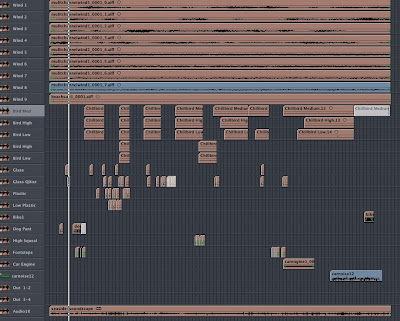
Draft Mix MP3
I aimed to recreate the sound of the windy seaside staying quite faithful to the events of the recording I made. The main elements I included were wind, birds, cars, dog, rumble, rummaging, and footsteps. Part of the objective was for the final product to have a hyper-real sheen to it, which allows for some deviation from the original recording.
In order to achieve the hyper-real texture, synthesis was my main approach to sound creation. My main synthesizer was Plogue Bidule, as its flexible modules and routing options allow for a wide variety of timbres. I found some sounds far harder than others to generate.
Wind was a main focus, because it was dominant in the original recording. I created a Bidule patch with 8 channels of noise and independent filters. The frequency of the filters was determined by independent random oscillators, and also a master control, so that the 8 channels are independent but linked to some degree. A rumble adds depth and cinematic hyper-realism. While I have tried to evoke the sea using wind and rumble sounds, I think that the real ocean does make water sounds that my simulation lacks.
Glass was also tackled with Bidule, using an FM synthesis patch with modulation envelopes. After generating files of randomly varied glass sounds, I compiled them in logic to simulate the simultaneous clinking of many bottles. Many different sequences were bounced from separate logic session and later used in the main session.
Percussive hitting sounds proved to be some of the most difficult to recreate. I tried to process white noise, but my results were largely corny and reminiscent of poor films. In this case, I abandoned synthesis and quickly recorded myself hitting various objects on the desk in front of me. By taking small portions of this recording, timestretching them and using EQ, reverb and enveloping, I was able to create some marginally better foley sounds. I think that these percussive sounds are the weak point of the work – particularly the footsteps.
In the final mix, heavy EQ and short reverbs proved to increase the realism of many of the sounds. Pan automation allowed elements such as cars, bikes and dogs to move around.
I’m satisfied with my final product, however I think that improvement is possible, particularly with the rummaging sounds. Through this exersize, I have realised how difficult synthesizing real sounds is.
No comments:
Post a Comment